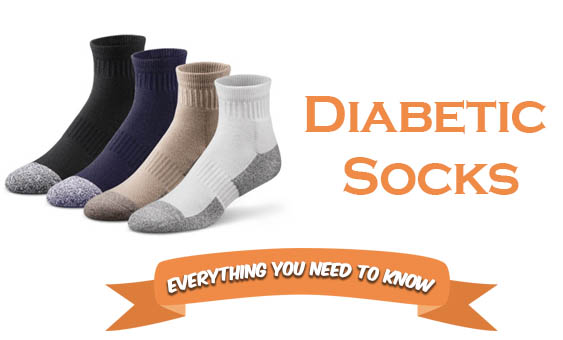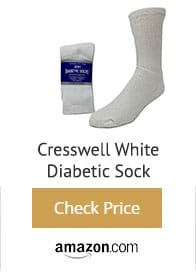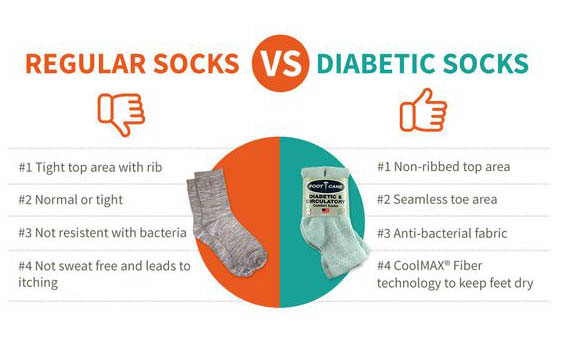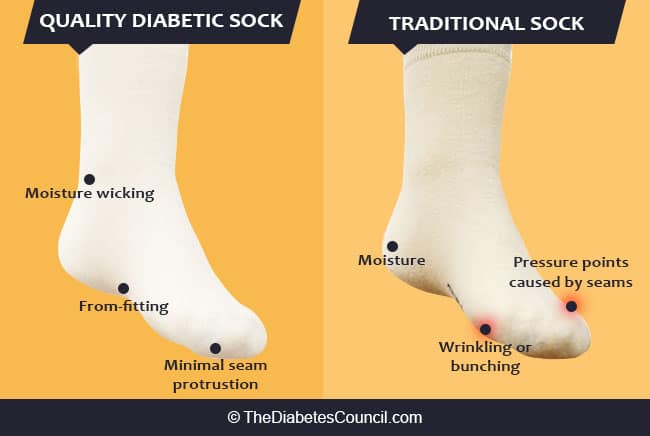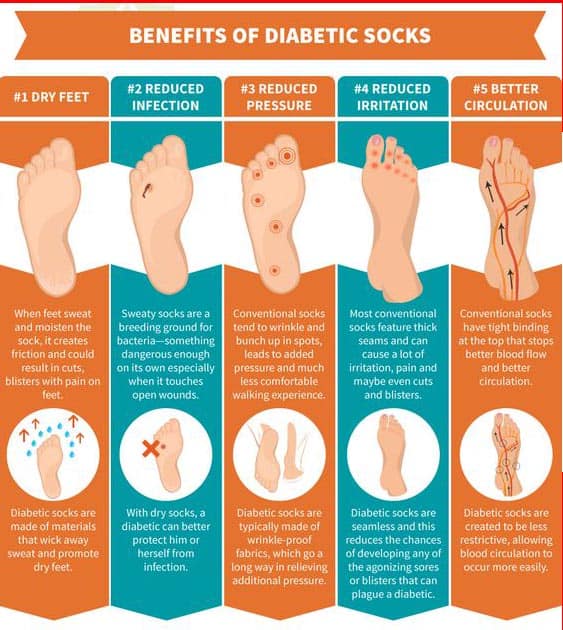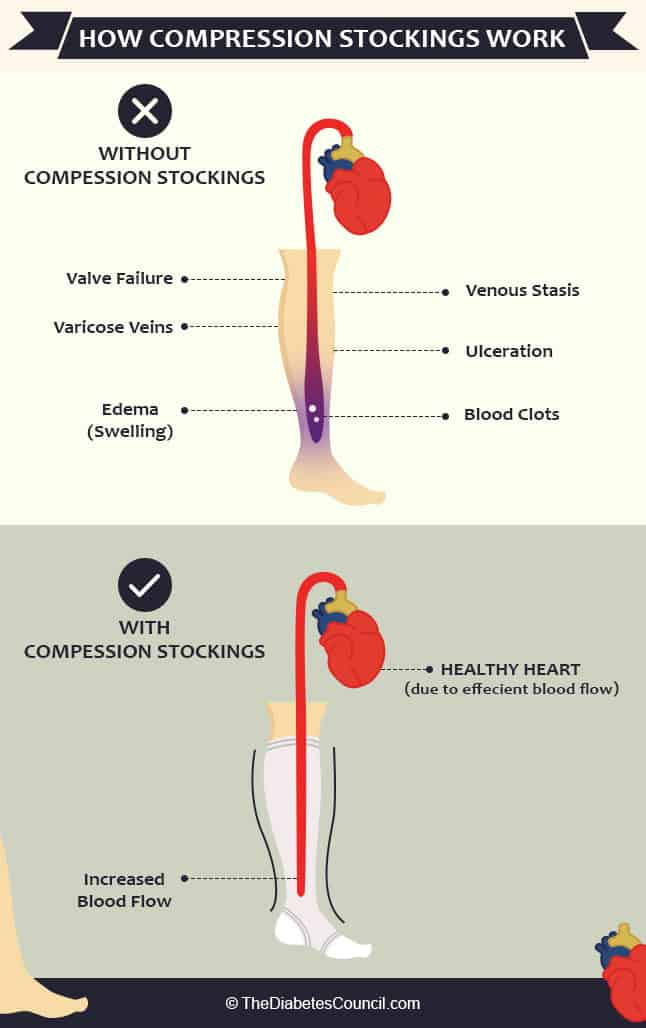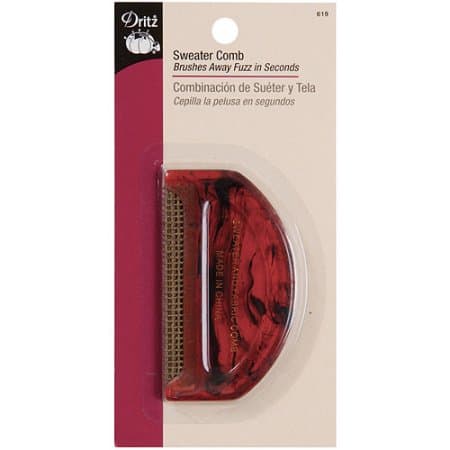Diabetes is a disease that requires many medical equipment for daily treatment and monitoring. The most common supplies includes blood glucose monitor, glucose test strips, lancets, and syringes.
Although not a lot of people consider diabetic socks a necessity, they are crucial to better health and prevention of various complications. If you are wondering if you should invest in diabetic socks, this article will help you decide by explaining these topics below:
Contents
- Best Diabetes Socks & Comparison
- What are Diabetic Socks?
- Who Should Use Diabetic Socks?
- Types of Diabetic Socks
- When to Wear These Socks?
- How Do Diabetic Socks Differ From Compression Socks and Regular Socks?
- What are the advantages of using diabetic socks?
- What Are the Disadvantages of Using Diabetic Socks?
- What is Venous Insufficiency?
- Diabetic Socks Can Prevent Amputations
- Are diabetic socks a misnomer?
- Where to Buy Diabetic Socks?
- Tips for Choosing Diabetic Socks
- How to Clean and Maintain Your Diabetic Socks
- Are Diabetic Socks Covered by Medical Insurance?
- Other Helpful Footcare Equipment to Consider
Best Diabetes Socks & Comparison
What are Diabetic Socks?
Diabetic socks are specially designed socks to 1) reduce pressure in the lower leg and foot, 2) prevent blistering on the skin surfaces, and 3) minimize moisture accumulation. Ultimately, their jobs are to protect your feet and provide maximum comfort. These socks are typically non-elastic and seamless. The non-elastic feature is to prevent constriction due to common feet swelling tendencies. The seamless design is to minimize friction to the nerves and minimize neurological discomfort and pain. These socks simply fit well to prevent restrictions in the calf from a tight sock line that can limit circulation. When circulation is decreased, it becomes harder for the body to heal. High blood sugar which is associated with diabetes also causes the immune system to slow down. Specialized socks are one way to combat this duo of issues to prevent the need for future amputation or even death due to foot injury.
Aside from the two special structures, these socks are always slightly cushioned to prevent injury. At the same time, there are reinforced moisture-wicking ability so that sweat and humidity from your shoes are not trapped between the sock and foot. By keeping your feet dry, your feet are at less risk of developing blisters and fungal infections.
Who Should Use Diabetic Socks?
Not all people with diabetes are required to wear diabetic socks. Diabetics with decreased pedal pulses (measured at the top of the foot and behind the inner ankle), changes in color and temperature of the feet, nerve damage or other changes in sensation or who frequently get foot injuries such as friction rubs should consider making the switch to solely diabetic socks for better protection are definitely candidates for diabetic socks. If your feet are sensitive to temperature changes, and they are prone to redness, irritation spots, and/or swelling, it is also highly recommended that you should wear them. If none of these symptoms are present, you can wear any type of socks. Still you should avoid wearing constricting, loose and lumpy socks or those with uncomfortable or rubbing seams.
If you are currently pregnant and suffer from gestation diabetes, these socks will be most beneficial to your swollen feet. Lightweight and highly breathable, they will keep your feet warm and lessen your chance of developing blood clots and deep vein thrombosis (DVT).
Although you may not need diabetic socks on a regular basis, you may think about getting a pair when you travel. With long hours of sitting, your feet are prone to swelling. To keep your feet warm without the elastic bands binding against your skin, these diabetic socks is a perfect travel companion. Traveling is a bit dangerous, so it's recommended that anybody who travels gets travel insurance. It's often said that if you cannot afford travel insurance, then you cannot afford to travel.
Types of Diabetic Socks
Diabetic socks can be found in many varying materials and lengths. There is even a new design called the “smart diabetic sock.”
For more diabetes information read the following:
- If I Have Diabetes, Will I Have to Stop Eating Sugar?
- How Can Your Diabetes Affect Your Friends, Family & Others Around You?
- Most Annoying Things People Say To You Or Your Children With Diabetes
- What are Blood Sugar Target Ranges? What is Normal Blood Sugar Level?
- Diabetes Care & Management: How Can I Measure My Progress?
Material
Diabetic socks are often made from a combination of materials such as acrylic, merino wool, bamboo, charcoal mixed with spandex for stretch. These materials offer more moisture wicking ability than the traditional cotton sock while spandex is less constricting than elastic. In addition, these materials are wrinkle-resistant to minimize the chances of material abrasion on skin.
When injury combines with bacteria and moisture, this complication can turn into a huge danger for individuals with diabetes. Therefore, being anti-microbial is an important feature for diabetic socks to prevent bacterial and fungal growth on humid and moisture prone region of the feet. What is also amazing about these socks is that the non-cotton materials such as wool, bamboo, and charcoal have natural anti-microbial properties. In addition, some higher-end diabetic socks even contain silver or copper threading to actively fight against bacteria and fungi, and prevent foot odor and infection.
Padding
Depending on your specific activity needs, you can purchase specialized diabetic socks with extra padding and different thickness level. If you need to remain on your feet daily for extended amount of time, you would want socks that have padding on your heels for extra support. If you run or exercise often, you may require socks with more padding at the ball of the foot to avoid friction-induced ulcer. On the other hand, other sports such as tennis and soccer will require toe padding to avoid possible toe-related injuries.
The padding can be made out of the socks fibers itself by increasing the number and thickness of thread loops. Gel padding is also a great option. Some gel formulas are proprietary; others are made of materials such as silicone. Regardless of the type of padding, research has found that padding further supports the socks purpose in moisture-wicking, minimizing sensitivity and irritations, relieving aches, and protecting from injury.
Available Styles and Lengths
Diabetic socks can be purchase based on your purpose. In general, over the calf and over the knee styles are most beneficial to individuals with circulation issues. If you have an active lifestyle, sport diabetic socks are available in both ankle and crew heights and continue to offer all of the benefits and standards of a classic diabetic sock. Since the invention of the original diabetic socks, various brands have introduced much more different pattern and color designs to the collection. Unlike the plain white or skin tone compression socks, these stylish diabetics socks easily fit your work or casual dress fashion needs. And for those individuals who do not like their socks to show, low-cut and Merry Jane style socks are also able in specific brands.
Smart Diabetic Socks
One of the newest developments in diabetic socks has been the “Smart Sock.” These socks utilize fiber-optic sensors to monitor pressure, moisture and foot joint angles to warn of the potential development of ulcers in those with nerve damage. The thought is that they can greatly reduce the amount of amputations and death due to foot ulcers and infection since nerve damage leaves the affected person without the ability to feel pain.
When to Wear These Socks?
It is typically recommended that individuals should put on their diabetic socks from the time they step out of bed in the morning until right before they go back to bed at night. The less time you are barefooted, the less likely you injure your feet by accidentally kicking things or stepping on items. Aside from lessening the friction on the foot from the floor surface, the socks can also maintain your feet at an optimal temperature for better blood circulation.
Having said that you should wear socks as much as possible, you should change your socks throughout the day as needed. If you exercise or play a sport, you should remove the socks, thoroughly clean your feet from sweat and moisture, and put on a new pair of clean socks afterwards. As a matter of fact, many diabetes individuals also choose to have socks for various tasks throughout the day such as, house socks, athletic socks and work socks.
When traveling, especially by air, anyone with circulatory issues should choose diabetic socks with light compression that fully cover the calf and/or the knee if possible. The socks will greatly help to keep a good return of circulation to the heart from the lower legs and feet. If you wear socks with copper and silver threading, you should not worry about the socks setting off the security checkpoint alarms as there is not enough metal to set-off the metal detector. If you have any worries, please let the officers know ahead of time of your socks and bring along your doctor’s recommendation for the diabetic socks. In case the detector do go off, the officers will remain much more understanding.
How Do Diabetic Socks Differ From Compression Socks and Regular Socks?
When you see the price of a pair of diabetic socks, it usually ranges around the price of a pair of good quality wool socks. So what makes them different from a pair of regular socks? Here is an in-depth look:
Regular socks
Traditional socks are often loose fitting and stretched out easily with lumps forming around your heels and beneath your toes. They contain a main seam that runs across the toes that can irritate sensitive pressure points in the feet. They are also typically made of cotton and elastic which not only traps moisture from escaping from between the sock and foot, but also impair circulation at the top of the sock which can grow tight around the wear throughout the day.
Diabetic Socks
Diabetic socks, on the other hand, fits your feet optimally. They conform to the wearer’s feet rather than strangling them. They are neither the traditional sock, nor a compression sock. They contain no elastic and have minimal or no seams. They do not form lumps even when they are worn or stretched out. To better fit the wearer and to avoid excess fabric creating lumps, the manufactures have taken more effort to produce more accurate sizes for ideal fitting. And to lessen rough abrasion on the skin, diabetic socks are often made from finer texture fabrics out of materials such as wool, bamboo, charcoal, nylon, and spandex blends. In addition, as explained earlier, diabetic socks have extra padding and cushioning at sensitive pressure point areas to further prevent injury from friction. Most of the time, cushioning runs along the bottom of the sock, around the toes, and at the heel of the foot.
Compression socks
Compression socks serves a main purpose of exerting enough pressure around your legs to force to increase the blood pressure needed to pump blood back up the veins. This process allows more blood to be quickly returned to the heart and prevents swelling and blood clots formation. They are used by athletes to enhance their performance or for medical conditions like edema, venous insufficiency, varicose veins, lymphedema, and deep vein thrombosis, as well as during pregnancy. Unlike regular socks and diabetic socks, these compression socks are tight and binding. Due to the specific sizing requirement, they are expensive.
Compression for diabetics
While some diabetics also suffer from peripheral arterial disease it is an important distinction to make that compression socks are not an appropriate option. According to the American Diabetes Association, 1 out of every 3 people with diabetes over 50 years old also have peripheral arterial disease. This additional condition increases their risk of heart attack or stroke occurrence. PAD is especially atherosclerosis in the legs that is partial or complete in the arteries. If you were to add compression from all side of the lower leg as compression socks do, you would be likely to further restrict the flow of oxygenated blood into this already deprived area, greatly progressing the wearer towards future amputation.
Diabetics can get diabetic socks with mild compression though which can be both helpful and safe. These typically raise the blood pressure by an easy 10-15 mmHg, whereas compression socks raise the blood pressure by around 20 mmHg and some compression stocking can increase it by 25-40 mmHg. Some hospitals use diabetics and/or compression socks when a patient cannot move a great deal or has to remain in their beds. They also may be used after major surgeries to insure good circulation form the legs. But unless prescribed the doctor, a diabetes patient should not attempt to wear compression socks.
What are the advantages of using diabetic socks?
The general advantage of wearing diabetic socks is protection and increased awareness.
- Protect from friction rubs, blisters and ulcers
- Cushion the feet from injury and rubbing
- Do not wrinkle and cause discomfort
- Conform to the feet without being constricting
- Do not contain tight irritating elastic fibers
- Show the presence of blood or other discharge from injuries
- Anti-microbial: fight odor and bacterial infection
- Can provide mild compression for better circulation
- Protects sensitive pressure points
- Minimize the risks involved in future amputations
What Are the Disadvantages of Using Diabetic Socks?
There really are no disadvantages to wearing diabetic socks, unless you don’t like having comfortable feet! Even people without diabetes can wear these socks if they want a more comfortable feel. You may have to purchase a slightly larger shoe size to accommodate for the padding in some diabetic socks though.
What is Venous Insufficiency?
Venous insufficiency is when the veins do not function properly and blood does not readily flow back to the heart. This venous stasis causes pooling of blood in the lower legs, ankle and feet. The most obvious symptom is the swelling of the feet. Other symptoms of venous insufficiency include:
- Pain in the legs while standing that decreases when you elevate the legs due to improved blood return to the heart
- Leg cramps and a feeling of tightness
- Itching and thickening of the lower leg skin
- Color change of the skin in the lower legs and/or feet
- Developing ulcers on the legs or feet
- Varicose veins
- Throbbing pain in your legs
- Your legs feel heavy and weak
In general, people that suffer from venous insufficiency are recommended to use compression socks to help increase their blood pressure in the lower leg by narrowing the diameter of the blood vessels. While diabetics should not wear true compression socks, those with venous insufficiency can choose to wear diabetic socks for mild compression purposes.
Diabetic Socks Can Prevent Amputations
For diabetics, amputations are typically due to a collection of tissue infections and poor blood circulations. The culprit is due to diabetic neuropathies that significantly decrease the awareness of foot injuries. When left untreated, unknown minor injuries and foot ulcers can develop into serious infections that eventually affect the bone and then the whole foot. When too much tissues and blood vessels are infected, amputation of the affected limb is the only option.
According to the American Diabetes Association, in 2010 nearly 73,000 non-traumatic lower-limb amputations occurred in diabetics aged 20 years old or older. This was about 60% of the total non-traumatic lower-limb amputations in this age group. In the United States, more than 90% of the performed amputations are due to circulations issues from diabetes with 60-80% of these being lower leg or foot amputations.
To avoid amputations, the best method is to prevent foot ulcers and injuries from happening in the first place. Aside from your usual diabetes regimen and proper foot care, your footwear plays an essential role to keep your diabetes symptoms in check. Although the health care system has not included diabetic socks as necessities for diabetes patients, you should still explore whether diabetic socks will help you to maintain an active lifestyle.
Are diabetic socks a misnomer?
The answer is no. Diabetic socks are solely designed with all of the specific requirements needed for comfortable and healthy feet needed for diabetes individuals. Anyone can wear these socks just for the quality and the higher comfort features, and some people with circulatory issues can benefit from the specific elastic designs. But it is the diabetes individuals would truly benefits from ALL the design features and see the change in their lifestyles.
Where to Buy Diabetic Socks?
You can buy diabetic socks just about anywhere. Many of the chain stores like Walmart, Target, Costco, Sears, and K-Mart carry them, as do a variety of pharmacies such as Rite-Aid, CVS, Kinney’s and Walgreens. They are also available to buy online at Amazon, Google and specialty sock companies. Online is a great option when you need to look for a specific type of diabetic sock as there are much more options and brands available.
One of the most recognized brands of diabetic socks is Sigvaris. This Swiss company sells a variety of compression socks including many types of diabetic socks and stockings offering graduated moderate compression for swelling. Their products are well researched with information on their products and conditions they can help available right on their website. They have socks of varying compression levels for casual, business and athletic times. You can visit the official Sigvaris website for more product details. Although they do not sell their socks directly on their website, you can find many online stores that carry their products.
Dr. Scholl’s is another well-known brand for condition specific socks. Unlike the other brands, Dr. Scholl’s specializes in general all around foot care and health. To cater to the storefront customers who may not have heard of diabetic socks, Dr. Scholl’s offer a much affordable price than the specialized brands like SmartKnit, Sigvaris, and Activa. Although there are less customized styles, they offer compression, relaxed fit, non-binding socks that are cotton and latex free. They also sell anti-microbial socks they call Silvadur which have silver threads mixed into the blend. Dr. Scholl’s offers a sock specifically for those with neuropathy as well that are extra soft and prevent slipping by adding grippers for traction.
If you wish to do some window shopping online, DiabeticSockShop.com and ForYourLegs.com are two excellent online shops that carry many brands of diabetic socks and compression socks. If you know exactly what you want and hope to score a deal, Amazon and eBay are the places to search. However, please note that ForYourLegs.com offers a low price guarantee where they will beat any advertised price by 10%. So if you see a cheaper price elsewhere online, you may want to contact them to see if you can score an even better deal.
Price Range of Diabetic Socks
When it comes to price, a pair of diabetic socks ranges anywhere from $2 to $140 depending on the material, the style, and the tightness of the socks. In the lowest range, you have Dr. Scholl’s Diabetic and Circulatory Basics Non-binding Ankle Socks for $7.84 in a 4 pack size at Walmart.
On the expensive end, if you are looking for very specific styles such as a pair of Sigvaris skin tone open toe knee-highs stockings, the price will be $123 or a pair of Mediven Swarovski studded Glamour Panyhose for $115. So unless you have specific needs, daily wear diabetic socks are actually very affordable and probably made to last longer than your average normal socks.
Tips for Choosing Diabetic Socks
Although there are so many styles and designs to choose from, white diabetic socks are often recommended for daily wear. This is because it is the easiest for you to detect any injuries to your feet. Especially for people with nerve damage, the white color will allow the wearer to spot any blood or discharge from wounds or calluses. At the same time, it is the easiest for the wearer to see if the socks are dirty and needed to be changed.
When it comes to length, taller socks that cuts over the knee are over the calf height are the typical recommendations. The height of these socks improves circulation and are greatly beneficial for wound healing and minimizing swelling in the feet and ankles due to decrease blood pressure.
Whatever what brand, size, and style of diabetic socks you are buying, you should buy just one pair to see how you like them first. It may take couple trial and errors to find the right size and brand for you. Afterwards, you can buy more to accommodate your needs. However, be on the lookout of newer, better styles. Do not be afraid to try other brands as well as sometimes styles are put to end and brands may go out of business. But do not attempt to overstock because of this reason. Just like anything else, fabric can age and lose its natural elasticity. Even without wearing them, your brand new socks will have less elasticity and can tear much easier just by sitting in the storage.
How to Clean and Maintain Your Diabetic Socks
You should wash your diabetic socks as soon as possible after wearing them to prevent any bacteria growth, especially if you have ulcers, blisters or calluses that leak a discharge.
It is generally recommended to wash your diabetic socks in warm water without bleach and tumble dry on warm as you would with your delicate under clothing items. Do not attempt to wash and dry the socks in high heat thinking that you can kill the bacteria easier this way. The heat will cause the fibers such as wool and spandex to lose their elasticity and ruin your socks. If you want to make the most out of your socks, hand wash and air dry the socks.
The more delicately you handle the socks, the longer it will last. If you truly have no time to hand treat the socks, put them into a undergarment wash bag before you put them into the washer and dryer. This way will minimize the fabric pilling from forming.
Another factor to consider is the detergent you use to wash these socks. Some diabetic sock manufacturer has produced their own line of cleaning solution for the socks. Simply handwashing the socks with the solution will be fine. If you have a cleaning solution for your under garments, it will do nicely with the socks as well. As these solutions are made for sensitive skin, the possible residue will be less irritating to your feet.
In terms of longevity, the diabetic socks typically last about 6 months with regular wear. But they should be thrown away at the first sign of wear or tear. Although fabric pilling may seem trivial, it can actually cause friction rub injuries like blisters. To save your socks for a few more wears, you can use a fabric shaver or a sweater comb to remove the minor pilling.
This $5.99 Dritz Sweater Comb is a little gadget can easily save you a few pair of diabetic socks.
For more speedy remedy, this Conair Fabric Shaver can quickly remove all your fabric pillings and return your socks to their smooth texture.
Which One To Pick?
The White Diabetes Socks are a good sock for the price, it slips on and off easily, decently padded with breathability, but do not compare it with a higher end sock as there are of course differences in material. These are not high quality, but do the job.
Bamboo is a better quality material than Cotton, and allows more breathability. Even not being white can be glossed over as sometimes you need non white socks for special events. The socks should and could use more padding on them, and they are shorter than the picture depicts.
Dr. Scholl’s is a very famous brand of socks, and are quite popular. Their socks are relatively thin for diabetes socks. You have to look around for one that is good.
Medipeds are another popular brand of diabetes socks. They are a bit on the thin side, and do not compress very well.
Are Diabetic Socks Covered by Medical Insurance?
As of current insurance policies, neither regular medical insurance nor Medicare covers diabetic socks. Having said that, diabetic socks may be covered through your Medicare Advantage plan or a group employment insurance plan. To confirm coverage, it is best to call your insurance provider and ask about your benefits. There is also the method of claiming the socks as your healthcare needs in your tax deduction. If you choose this method, you should have your doctor document the diabetic socks as a recommendation for your diabetes treatment. You should also pay attention to the regulations for medical-related expense deduction and that you are required to itemize your expenses to qualify for deduction.
Further reading:
How to Save on Diabetic Socks?
If you are a frequent shopper at certain stores such as Walgreens, Walmart, Target, and CVS, they all have cash back and point rebate programs that will allow you to save some money on purchasing your diabetic socks. If you are an online shopper, many online stores offer promotion codes for first time customers. Sometimes specific brand names will have coupon code on their official website as well. If you are loyal to a certain brand, make sure to sign up on their mailing list. Sometimes they will send you samples along with coupons for your future purchases.
Another option to save is to look on eBay. As some stores go out of business or decide to discontinue certain styles, they may list certain diabetic socks on a low bulk price. If you have an active lifestyle and require to change your socks very frequently, this is definitely a method to explore. However, make sure all the socks are brand new! Do not attempt to buy second-hand socks as the previous owner may have athletic feet or various fungal infection. No matter how well you wash the socks, the fungus and bacteria can still remain in the fabric.
Other Helpful Footcare Equipment to Consider
You should know that if you are wearing padded diabetic socks, you may need a slightly larger shoe size to accommodate for the extra material.
If you have healthy feet and normal sensation, wearing regular shoes should not be a problem.
For other, specific diabetic shoes can be purchase and many times are covered by Medicare. Diabetic shoes preventing pinching, heel blistering and other discomforts that can cause injuries. They typically have a large wide toe box and are made of soft leather. Brands such as CrocsRx, PW Minor, Drew and Easy Spirit make diabetic shoes. Extra deep shoes called “depth shoes” can be order through a podiatrist to accommodate shoe inserts for comfort and support as well.
It is important to remember: While diabetic socks may help protect the feet, it’s just one part of the equation in healthy foot care for diabetics.
As recommended by the American Diabetes Association, you should follow these tips as well:
- Inspect your feet daily for temperature and color changes and injuries.
- Wash your feet daily to prevent bacteria growth. Be sure to dry them gently but thoroughly.
- Don’t try to remove calluses or other skin build-up without a doctor. Have your feet inspected by a podiatrist and any doctor you see for new wounds.
- Trim toenails with care! File them smooth but be careful of the skin. If you are not comfort cutting your own nails, often the doctor or your caregiver will do it for you.
- Never go barefoot. Not even in the house.
- Always wear clean, dry socks.
- Be sure your shoes fit properly. They should not be too tight or too loose as both can cause big problems. If needed, get customized orthotic shoes.
- Do not smoke! Smoking increase circulatory issues, impairs wound healing, and increases your risk of future amputation.
- Take all foot injuries seriously. Small injuries can escalate quickly when you have poor circulation and immune system. Monitor all injuries and be sure to show them to your doctor. Always go to your follow-up appointments to be sure you are healing properly.
This was the most comprehensive diabetes sock article we could make, hopefully it was helpful. If you have stories or comments share them down below.
TheDiabetesCouncil Article | Reviewed by Dr. Sergii Vasyliuk MD on June 03, 2020
References
- Perrier A, et al. Smart diabetic socks: embedded device for diabetic foot prevention. Accessed on: 9/8/16.
- Surgery Encyclopedia Amputation. Accessed on: 9/8/16.
- Amputation and diabetes: How to protect your feet. Accessed on: 9/8/16.


